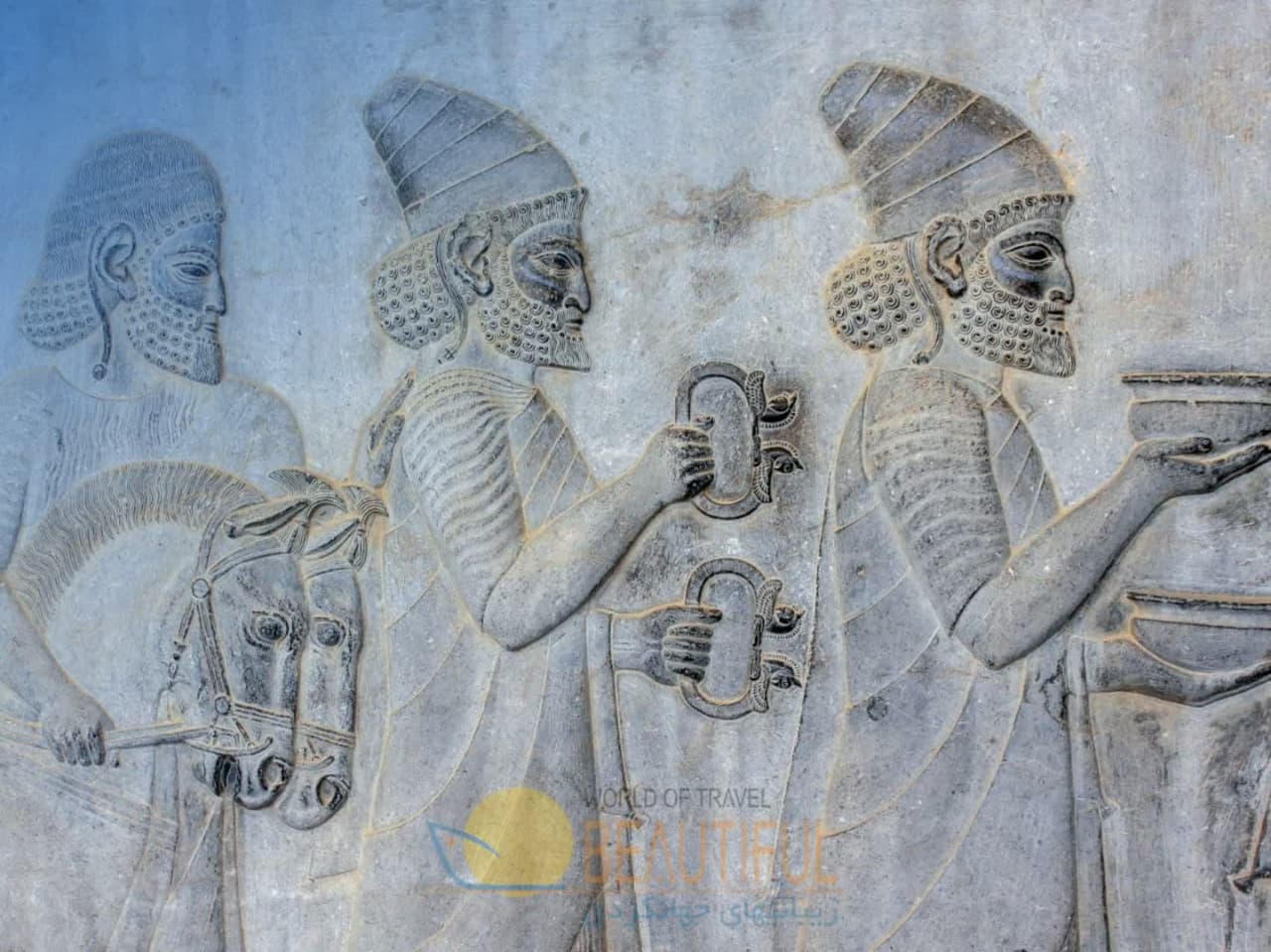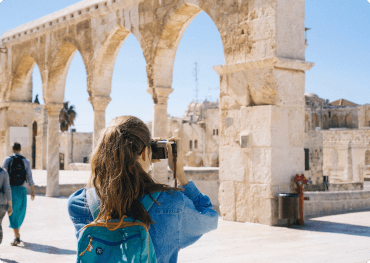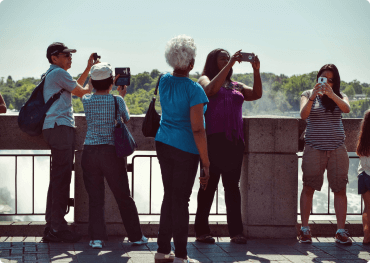
CU-127
Package Details
Day 1: Flight from your home country to Tehran capital of IRAN
We prepare ourselves for a fabulous trip to Great Persia.
Arrival to Tehran, after custom formality, meet and assist at airport and
Transfer to the Hotel.
Day 2: Tehran
After breakfast in hotel, we prepare to start for city sightseeing, visit Niyavaran Palace,
Lunch in a local restaurant during the visit .In the afternoon visit Bazaar Tajrish and Imamzadeh Saleh mausoleum.
Dinner in local restaurant and return to the hotel
The Niavaran Complex is a historical complex situated in Shemiran, Tehran (Greater Tehran), Iran. It consists of several buildings and monuments built in the Qajar and Pahlavi eras. The complex traces its origin to a garden in Niavaran region, which was used as a summer residence by Fath-Ali Shah of the Qajar Dynasty. A pavilion was built in the garden by the order of Naser ed Din Shah of the same dynasty, which was originally referred to as Niavaran House, and was later renamed Saheb Qaranie House. The pavilion of Ahmad Shah Qajar was built in the late Qajar period.During the reign of the Pahlavi Dynasty, a modern built mansion named Niavaran House was built for the imperial family of Mohammad Reza Pahlavi. All of the peripheral buildings of the Saheb Qaranie House, with the exception of the Ahmad Shahi Pavilion, were demolished, and the buildings and structures of the present-day complex were built to the north of the Saheb Qaranie House. In the Pahlavi period, the Ahmad Shahi Pavilion served as an exhibition area for the presents from world eaders to the Iranian monarchs.
Imamzadeh Sāleh is one of many Imamzadeh mosques in Iran. The mosque is located at Tajrish Square in Tehran's northern Shemiran district. The mosque entombs the remains of Sāleh, a son of the Twelver Shiah Imām, Musa al-Kadhim, and is one of the most popular Shia shrines in northern Tehran.
O/N: Tehran.
Day3: Tehran - Shiraz
After breakfast, visit Tehran Golestan Palace. After noon, transfer to train station travel to Shiraz.(departure at 16:20PM ) .We use night train to save one day for sightseeing, if we use to travel by air,we should go to the airport 4 hours before departure and have security check, it train we join with normal peoples and learn about habitant, customs and protocol. During rail trip, clients can drop in every station and know different peoples and culture.
The Golestan Palace : literally the Roseland Palace, is the former royal Qajar complex in Iran's capital city, Tehran.The oldest of the historic monuments in Tehran, and of world heritage status, the Golestan Palace belongs to a group of royal buildings that were once enclosed within the mud-thatched walls of Tehran’s Historic Arg (citadel). It is a masterpiece of beautiful garden and buildings consist of collection of Iranian crafts and European presents from 18th and 19th century. Golestan Palace Complex consists of 17 structures including palaces, museums, and halls. Almost all of this complex was built during the 200 years ruling of Qajarian kings. These palaces were used for many different occasions such as coronation and other important celebrations. It also consists of three main archives as the royal photographic archive collection 'Album khane', the royal library of manuscripts 'Ketabkhane Nosakhe khati' and the archive of documents 'Markaze asnad'.
O/N: In Train.
Day4: Shiraz
We arrive to Shiraz at 07:00AM, transfer from rail station to the hotel and check in.Full day city tour to visit Vakil complex (bath, museum & bazaar) as well as Karimkhani Citadel and Aramgah Hafez (tomb of the Iranian Poet).
The Vakil Mosque is a mosque in Shiraz, southern Iran, situated to the west of the Vakil Bazaar next to its entrance. This mosque was built between 1751 and 1773, during the Zandperiod; however, it was restored in the 19th century during the Qajar period. Vakil means regent, which was the title used by Karim Khan, the founder of Zand Dynasty. Shiraz was the seat of Karim Khan’s government and he endowed many buildings, including this mosque.
Vakil Bath is an old public bath in Shiraz, Iran. It was a part of the royal district constructed during Karim Khan Zand's reign, which includes Arg of Karim Khan, Vakil Bazaar, Vakil Mosque and many administrative buildings.The monument is inscribed with the number 917 on the list of national works of Iran.
Vakil Bazaar is the main bazaar of Shiraz, Iran, located in the historical center of the city. It is thought that the market originally was established in the 11th century AD, and was completed mainly by the Atabaks of Fars, and was renamed after Karim Khan Zand only in the 18th century.
The bazaar has beautiful courtyards, Caravansarais, bath houses, and old shops which are deemed among the best places in Shiraz to buy all kinds of Persian rugs, spices, copperhandicrafts and antiques. Like other Middle Eastern bazaars, there are a few mosques and Imamzadehs constructed beside or behind the bazaar.
The Tomb of Hafez and its associated memorial hall, the Hāfezieh, are two memorial structures erected in the northern edge of Shiraz, Iran, in memory of the celebrated Persian poet Hafez. The open pavilion structures are situated in the Musalla Gardens on the north bank of a seasonal river and house the marble tomb of Hafez. The present buildings, built in 1935 and designed by the French architect and archaeologist Andre Godard, are at the site of previous structures, the best-known of which was built in 1773. The tomb, its gardens, and the surrounding memorials to other great figures are a focus of tourism in Shiraz.
Optional tour in Shiraz
The Tomb of Saadi is a tomb and mausoleum dedicated to the Persian poet Saadi in the Iranian city of Shiraz. Saadi was buried at the end of his life at a Khanqah at the current location. In the 13th century a tomb built for Saadi by Shams al-Din Juvayni, the vizir of Abaqa Khan. In the 17th century, this tomb was destroyed. During the reign of Karim Khan was built a mausoleum of two floors of brick and plaster, flanked by two rooms. The current building was built between 1950 and 1952 to a design by the architect Mohsen Foroughi and is inspired by the Chehel Sotoun with a fusion of old and new architectural elements. Around the tomb on the walls are seven verses of Saadi’s poems.
O/N: Shiraz.
Day5: Shiraz – Yazd
Early morning, drive to Yazd (440KM), in the way visit Persepolis and Pasargadae.
Evening, arrival to Yazd. Check in the hotel and move to visit Amir Chakhmagh Sq, and Pahlevani and zoorkhaneh rituals.
O/N: Yazd
Persepolis the name of one of the ancient cities of Iran that joined over the years, the capital 's stately and ceremonial monarchy at the time of the Achaemenid Empire was. In this ancient city called Persepolis palace that during the reign of Darius , Xerxes and Artaxerxes was built and was built for about 200 years. On the first day of the New Year , many groups from different countries representing Satrapyha or governments gathered in Persepolis with diverse took offerings and gifts were presented to the king.
Persepolis in 518 BCE as the new capital of the Achaemenid the gamers began. Founder of Persepolis, Darius was, of course, after his son Xerxes and his grandson Artaxerxes I to extend this series to expand it added. Many existing knowledge about the history and culture of the Achaemenid stone inscriptions and Flznvshthhayy is available for the palaces and on the walls and the tablet is engraved. Sumner has estimated that the plain of Persepolis which contains 39 residential camp was in the Achaemenid period 43, 600 people had. Historians believe that Alexander the Macedonian commander Greek in 330 BC, invaded Iran and burned Persepolis and probably a large part of the books, Achaemenid art and culture destroyed by it. However, the ruins of this place is still up and archeology of its ruins signs of fire and rush to acknowledge it.
This place since 1979, one of Iran's record on the UNESCO World Heritage is.
Persepolis in the northern city near Shiraz , south of Fars province (northeast of Shiraz ) is replaced.
At a distance of six and a half kilometers from Persepolis, Naqsh-e Rustam is located.
Pasargadae World Heritage collection is a set of ancient structures Brjaymandh from the Achaemenid the city of Pasargadae in Fars Province lies.
This total includes buildings such as Tomb of Cyrus the Great , Pasargadae mosque , declared the king's garden , the palace gates , bridges, levee House , House suite , two pavilions , waterfront, garden cress, Tomb of Cambyses , defensive structures Tel bed , inn Mozaffari , sacred ground and Bolaghi Gorge is.
This set the fifth set is registered in the World Heritage List in Iran at a meeting of UNESCO in July of 1383 in China was held due to many factors hundred per cent on the World Heritage List was registered.
In 529 BC, Cyrus the tribes of the Scythians in Central Asia (North East of Iran) attacked and are at war with massagetae was killed. He was buried in Pasargadae.
Amir Chakhmaq Maidan Square in the city of Yazd is. Yazd Amir Chakhmaq of the market , relying , a mosque and two cistern dating back to the Timurid period is. Relying Amir Flint in 1330 and the mosque, Amir Flint in 1341 in the national index Iran were registered. Amyrchqmaq field, one of the most remarkable collections of historical and tourism is the city of Yazd.
Amyrjlalaldyn Chqmaq , captains and rulers of the Timurid Shahrukh in solar 8th century when the ruling was Yazd, a set of lean , square, public baths , caravanserais , monasteries , Qnatkhanh and cold water and in so doing promote the build up of Yazd Fatima Khatun, wife, helped him. In 1330 Hijri relying Amir flint and flint Emir Mosque in 1341 number 383 and number 247 on the national index were registered independent. The buildings and other accession as Amir Chakhmaq collection also reached number 2416 to the National Register.
Pahlevani and zoorkhaneh:rituals is the name inscribed by UNESCO for varzesh-e pahlavani or varzesh-e bastany, a traditional Iranian system of athletics originally used to train warriors. It combines martial arts, calisthenics, strength training and music. Recognized by UNESCO as among the world’s longest-running forms of such training, it fuses elements of pre-Islamic Persian culture (particularly Zoroastrianism, Mithraism and Gnosticism) with the spirituality of Shia Islam and Sufism.
Practiced in a domed structure called the zurkhaneh, training sessions consist mainly of ritual gymnastic movements and climax with the core of combat practice, a form of submission-grappling called koshti pahlevani.
Traditional Iranian wrestling (koshti) dates back to ancient Persia and Parthia and was said to have been practiced by Rustam, mythological hero of the Shahnameh epic. While folk styles were practiced for sport by every ethnic group in various provinces, grappling for combat was considered the particular specialty of the zourkhaneh. The original purpose of these institutions was to train men as warriors and instill them with a sense of national pride in anticipation for the coming battles. The Mithraic design and rituals of these academies bear testament to its Parthian origin (132 BC - 226 AD). The zourkhaneh system of training is what is now known as varzesh-e bastani, and its particular form of wrestling was called koshti pahlevani, after the Parthian word pahlevan meaning hero.
When the Arabs invaded Persia around 637 CE, the zourkhanehs served as secret meeting places where knights would train and keep alive a spirit of solidarity and patriotism. Invaders repeatedly targeted the houses of strength to discourage rebels, but new ones would always be organized in a different location. Following the spread of Shia Islam, and particularly after the development of Sufism in the 8th century, varzesh-e pahlavani absorbed philosophical and spiritual components from it. Religious hymns were incorporated into training, and the first Shi'ite imam Ali was adopted as the zourkhaneh patron.
Varzesh-e bastani was particularly popular in the 19th century, during the reign of the Qajar king Nassar al-Din Shah (1848–1896). Every 21 March on Nowruz (the Iranian new year), competitions would be held in the shah's court, and the shah himself would present the champion with an armlet (bazoo-band).
The sport declined following the rise of the Pahlavi dynasty in the 1920s and the subsequent modernisation campaigns of Reza Shah, who saw the sport as a relic of Qajarite ritual. Reza Shah's son Mohammad Reza Pahlavi took a different approach, emphasizing Iran's ancient Persian roots as an alternative to the heavily Islam-based identity of less developed nations in the Middle East. He attempted to revive the tradition and practiced it himself, and during his reign, the last national competitions were held.
Following the Iranian Revolution of 1979 the tradition lost some of its popularity as the new regime discouraged anything tied to pre-Islamic paganism, which included the Gnostic and Mithraic chants and rituals of the zourkhaneh. This did not last, however, as the Islamic Republic eventually promoted varzesh-e bastani as a symbol of Iranian pride and culture. Today, varzesh-e pahlevani is touted as the reason why Iranians are regular winners at international wrestling and weight-lifting events. The matter of attracting younger members has been a major discourse for some time. Suggestions have included making practice more upbeat and distributing duties among the younger members instead of adhering strictly to seniority. The IZSF was established in response to this and it is currently the world governing body for all zourkhaneh. In recent years, the sport appears to be gaining popularity in the countries adjacent to Iran, including Iraq and Afghanistan.The main portion of a varzesh-e bastani session is dedicated to weight training and calisthenics, notably using a pair of wooden clubs (mil), metal shields (sang), and bow-shaped iron weights (kabbadeh or kaman). This is followed by exercises like Sufi whirling and juggling, all of which are intended to build strength. The athletes move in unison to the drum beats of the morshed. Every session ends with bouts of koshti pahlevani.
Ancient Zoroastrians believed that the development of physical and mental strength could be used to enhance spirituality. Thus, aside from once preparing warriors for battle, this training is supposed to promote kindness and humility through the cultivation of outer strength. Under the supervision of a pishkevat, students are instructed in traditional ethics and chivalry. Participants are expected to be pure, truthful, good-tempered and only then strong in body. Acquiring the rank of pahlevan (hero) requires mastery of the physical skills, observance of religious principles, and passing the moral stages of Gnosticism. The principles of unpretentiousness are exemplified by a verse recited at many meetings: "Learn modesty, if you desire knowledge. A highland would never be irrigated by a river." (Kanz ol-Haghayegh)
Day6: Yazd- Isfahan
After breakfast, visit Zoroastrian fire temple, Dolat Abad Garden and Alexander prison.
Yazd fire whereabouts of the Zoroastrian sacred fire in the city of Yazd and Temple Zoroastrians residing in the city. The main building temples on height of about 21 meters off the ground and in the large yard trees evergreen cypress and pine covered, is located. Figure Forouhar and stone capitals that gives it a special beauty blue pond in front of the building. The temples of properties Altar of the water.
The Hall's main building and a wall of stone capitals flowering gems work of artists from Isfahan. This rock artists in Isfahan shaved and then to Yazd have. Tile journalist Forouhar on the entrance, a tile Yazdi artists and architecture of this building of architecture Corp fire temples was persuaded impact.
Fire inside the fire burns more than 1,500 years remains bright. This fire is in LARESTAN that Aghda Yazd was brought and kept clear there was nearly 700 years and then in 522 of Aghda in Ardakan Ardakan, Yazd were also nearly 300 years, and in year, 852 ducks were taken to the city. First, in a neighborhood called " Khalaf Ali Khan " a great priest in the house called " priest Adhargushasb shooter " was held in the year 1313 after the construction of the temple was brought into it.
Dolatabad garden from the gardens of the old city of Yazd in Iran and the rows Fin Garden in Kashan and Shazdeh Garden in Kerman is.
Windward Windward adobe building the tallest tower with a height of 33/8 meters known in the world.
The garden on 23/12/1346 in row No. 774 national monuments are located, and also one of the Persian Gardens registered in the World Heritage Site by UNESCO is.
Dolat Abad Garden in Yazd in late Afsharieh and in 1160. AH by Mohammad Taghi Khan, was established.
The late Mohammad Taqi Khan's first aqueduct during construction and 65 Km water from Mehriz to Yazd Dolat Abad Garden's current location and then rule sets founded their own.
The garden has an area of about 70/000 square meters, including buildings, ponds and waterfront, a lot of space between them in the gardens with trees, pomegranates and grapes and ... Baq hay abundance adorn their environment.
Alexander prison or Ziaieh school is a school with about eight centuries old, in fact, that in the neighborhood Fahadan the city of Yazd in the vicinity of the tomb of the twelve Imams actually been produced. The built in 631 AD by the famous mystic Zia Hussain Razi was built in 705 AD and was completed by his sons Majd Ali Hassan and Shafaruddin.
Parts of the building can be a hole with a diameter of about 2 meters in the middle of the school yard which has a depth of about 5 meters leads to the basement, dome of the monument to the height of 18 meters and decorating beauty with golden and blue color that much of it has been undermined.
The building is raised on stories dating from making it to the attack of Alexander the Macedonian to Iran than that of the building that was later repurposed been used as a prison and has been used as a school.
Afternoon drive to Isfahan (322 KM) via Naein on the way visiting Jame Mosque.
Evening, arrival to Isfahan.
Jameh Mosque of Nain: is the grand, congregational mosque (Jameh) of Nā'īn city, within Isfahan Province of Iran. Although the mosque is one of the oldest in Iran, it is still in use and is protected by Iran's Cultural Heritage Organization. The mosque is one of the oldest in Iran, dating back to the 9th century. The interiors however are Seljuki in brick craftsmenship, and therefore allude to the 11th century.
O/N: Isfahan
Day7: Isfahan
Full day visiting Isfahan: Naghsh e Jahan Square, Emam Mosque, Alighapoo Palace, Sheykh Lotf-ol lah Mosque, old Bazaar, Chehel soton.
O/N: Isfahan
Naqsh-e Jahan Square, known as Imam Square, formerly known as Shah Square, is a square situated at the center of Isfahan city, Iran. Constructed between 1598 and 1629, it is now an important historical site, and one of UNESCO's World Heritage Sites. It is 160 metres (520 ft) wide by 560 metres (1,840 ft) long (an area of 89,600 square metres (964,000 sq ft)). The square is surrounded by buildings from the Safavid era. The Shah Mosque is situated on the south side of this square. On the west side is the Ali Qapu Palace. Sheikh Lotf Allah Mosque is situated on the eastern side of this square and at the northern side Keisaria gate opens into the Isfahan Grand Bazaar. Today, Namaaz-e Jom'eh (the Muslim Friday prayer) is held in the Shah Mosque.The square is depicted on the reverse of the Iranian 20,000 rials banknote.
The Lotfollah Mosque : The Lotfollah Mosque had a secret entrance that spanned underneath the Maidan, from the Palace on the opposite side of the square.
Of the four monuments that dominated the perimeter of the Naqsh-e Jahan square, the Lotfollah Mosque, opposite the palace, was the first to be built. The purpose of this mosque was for it to be a private mosque of the royal court, unlike the Shah mosque|Masjed-e Shah, which was meant for the public. For this reason, the mosque does not have any minarets and is of a smaller size. Indeed, few Westerners at the time of the Safavids even paid any attention to this mosque, and they certainly did not have access to it. It wasn't until centuries later, when the doors were opened to the public, that ordinary people could admire the effort that Shah Abbas had put into making this a sacred place for the ladies of his harem, and the exquisite tile-work, which is far superior to those covering the Shah Mosque.
Ali Qapu is in effect but a pavilion that marks the entrance to the vast royal residential quarter of the Safavid Isfahan which stretched from the Maidan Naqsh-i-Jahan to the Chahar Bagh Boulevard. The name is made of two elements: "Ali", Arabic for exalted, and "Qapu" Turkic for portal or royal threshold. The compound stands for "Exalted Porte". This name was chosen by the Safavids to rival the Ottomans' celebrated name for their court : Bab-i Ali, or the "Sublime Porte"). It was here that the great monarch used to entertain noble visitors, and foreign ambassadors.
Shah Abbas, here for the first time celebrated the Nowruz (New Year's Day) of 1006 AH / 1597 A.D. A large and massive rectangular structure, the Ali Qapu is 48 m (157 ft) high and has six floors, fronted with a wide terrace whose ceiling is inlaid and supported by wooden columns.
On the sixth floor, the royal reception and banquets were held. The largest rooms are found on this floor. The stucco decoration of the banquet hall abounds in motif of various vessels and cups. The sixth floor was popularly called (the music room) as it was here that various ensembles performed music and sang songs. From the upper galleries, the Safavid ruler watched polo games, maneuvers and horse-racing below in the Naqsh-i-Jahan square.
The Bazaar of Isfahan is a historical market and one of the oldest and largest bazaars of the Middle East. Although the present structure dates back to the Safavid era, parts of it are more than a thousand years old, dating back to the Seljuq dynasty. It is a vaulted, two kilometer street linking the old city with the new.
Chehel Sotoun ( “Forty Columns”) is a pavilion in the middle of a park at the far end of a long pool, in Isfahan, Iran, built by Shah Abbas II to be used for his entertainment and receptions. In this palace, Shah Abbas II and his successors would receive dignitaries and ambassadors, either on the terrace or in one of the stately reception halls.
The name, meaning "Forty Columns" in Persian, was inspired by the twenty slender wooden columns supporting the entrance pavilion, which, when reflected in the waters of the fountain, are said to appear to be forty.
As with Ali Qapu, the palace contains many frescoes and paintings on ceramic. Many of the ceramic panels have been dispersed and are now in the possession of major museums in the west. They depict specific historical scenes such as the infamous Battle of Chaldiran against the Ottoman Sultan Selim I, the reception of an Uzbek King in 1646, when the palace had just been completed; the welcome extended to the Mughal Emperor, Humayun who took refuge in Iran in 1544; the battle of Taher-Abad in 1510 where the Safavid Shah Ismail I vanquished and killed the Uzbek King. A more recent painting depicts Nader Shah's victory against the Indian Army at Karnal in 1739. There are also less historical, but even more aesthetic compositions in the traditional miniature style which celebrate the joy of life and love.
The Chehel Sotoun Palace is among the 9 Iranian Gardens which are collectively registered as one of the Iran’s 17 registered World Heritage Sites under the name of the Persian Garden.
Day: 8 Isfahan - Kashan
After breakfast, visit Vank Cathedral and drive from Isfahan to Kashan (218 KM).
Holy Savior Cathedral is a cathedral located in the New Julfa district of Isfahan, Iran. It is commonly referred to as the Vank, which means "monastery" or "convent" in Armenian language.
The cathedral was established in 1606, dedicated to the hundreds of thousands of Armenian deportees that were resettled by Shah Abbas I during the Ottoman War of 1603-1618.
The varying fortunes and independence of this suburb across the Zayande River and its eclectic mix of European missionaries, mercenaries and travelers can be traced almost chronologically in the cathedral's combination of building styles and contrasts in its external and internal architectural treatment.
Optinal tour in Isfahan
The Monar Jonban (Shaking Minarets), or Menar-e-jomban, is a monument located in Isfahan, in central Iran. Construction began in the 14th century to cover the grave of Amu Abdollah Soqla. Its notable feature is that if one of the minarets is shaken, the other minaret will shake as well.
In Kashan visit Brojerdi old house , Fin Garden.
Fin Garden, or Bagh-e Fin, located in Kashan, Iran, is a historical Persian garden. It contains Kashan's Fin Bath, where Amir Kabir, the Qajarid chancellor, was murdered by an assassin sent by King Nasereddin Shah in 1852. Completed in 1590, the Fin Garden is the oldest extant garden in Iran.
The origins of the garden may be anterior to the Safavid period; some sources indicate that the garden has been relocated from another place, but no clear picture of it has been found.
The settlements of the garden in its present form was built under the reign of Abbas I of Persia (1571-1629), as a traditional bagh near the village of Fin, located a few kilometres southwest of Kashan.
The garden was developed further during the Safavid dynasty, until Abbas II of Persia (1633-1666). It was highly recognized during the reign of Fat′h Ali Shah Qajar and was considerably expanded.
The garden subsequently suffered from neglect and was damaged several times until, in 1935, it was listed as a national property of Iran. On 2007, 8 September, Bagh-e Fin was submitted to the Unesco's Tentative List. Unesco declared the garden a World Heritage Site on July 18, 2012.
Home Borujerdian the historic city of Kashan is. The building is located in the neighborhood Sultan Mir Ahmad and in the second half of the 13th century Hijri built in Qajar era and was registered under the number 1083 in the national index. The house has a beautiful crescent-shaped symmetrical vents on the roof of the hall and pergola on one of the most beautiful manifestations of Persian architecture to display it. So that the inscriptions on all four sides of the hall, the building dates back to 1292 BC E…
The owner of the house, Haj Seyed Mehdi Natanz businessmen residing in Kashan and architect of the master Ustad Ali Maryam was. Because of his many trips to the city of Boroujerd have known Boroujerdi. Boroujerdi House in Kashan Cultural Heritage Administration is now home.
Borujerdian historic house in Kashan in terms of popularity tourist attraction as a top choice UNESCO in 2015 and 2016 respectively.
In the evening we return toward International airport, on the way we stop for dinner in tourist complex
After dinner, we continue to go to the airport hotel to take hourly rest.
Day9: Departure
Fly to your home country and ending memorable trip to Great Iran. See soon again with different program in Iran
OPTIONAL TOURS:
We have several interesting sites are not included in our program if any of clients would like to visit specific sites,
We can arranged it at extra cost.
Details
Pellentesque accumsan magna in augue sagittis, non fringilla eros molestie. Sed feugiat mi nec ex vehicula, nec vestibulum orci semper. Class aptent taciti sociosqu ad litora torquent per conubia nostra, per inceptos himenaeos. Donec tristique commodo fringilla. Duis aliquet varius mauris eget rutrum. Nullam sit amet justo consequat, bibendum orci in, convallis enim. Proin convallis neque viverra finibus cursus. Mauris lacinia lacinia erat in finibus.
Pellentesque accumsan magna in augue sagittis, non fringilla eros molestie. Sed feugiat mi nec ex vehicula, nec vestibulum orci semper. Class aptent taciti sociosqu ad litora torquent per conubia nostra, per inceptos himenaeos. Donec tristique commodo fringilla.
- Specilaized Bilingual Guide
- Private Transport
- Entrance Fees
- Box Lunch,Water,Dinner and Snacks
Pellentesque accumsan magna in augue sagittis, non fringilla eros molestie. Sed feugiat mi nec ex vehicula, nec vestibulum orci semper. Class aptent taciti sociosqu ad litora torquent per conubia nostra, per inceptos himenaeos. Donec tristique commodo fringilla.
- Specilaized Bilingual Guide
- Private Transport
- Entrance Fees
- Box Lunch,Water,Dinner and Snacks
Pellentesque accumsan magna in augue sagittis, non fringilla eros molestie. Sed feugiat mi nec ex vehicula, nec vestibulum orci semper. Class aptent taciti sociosqu ad litora torquent per conubia nostra, per inceptos himenaeos. Donec tristique commodo fringilla.
- Specilaized Bilingual Guide
- Private Transport
- Entrance Fees
- Box Lunch,Water,Dinner and Snacks
Pellentesque accumsan magna in augue sagittis, non fringilla eros molestie. Sed feugiat mi nec ex vehicula, nec vestibulum orci semper. Class aptent taciti sociosqu ad litora torquent per conubia nostra, per inceptos himenaeos. Donec tristique commodo fringilla.
- Specilaized Bilingual Guide
- Private Transport
- Entrance Fees
- Box Lunch,Water,Dinner and Snacks
Pellentesque accumsan magna in augue sagittis, non fringilla eros molestie. Sed feugiat mi nec ex vehicula, nec vestibulum orci semper. Class aptent taciti sociosqu ad litora torquent per conubia nostra, per inceptos himenaeos. Donec tristique commodo fringilla.
- Specilaized Bilingual Guide
- Private Transport
- Entrance Fees
- Box Lunch,Water,Dinner and Snacks






















